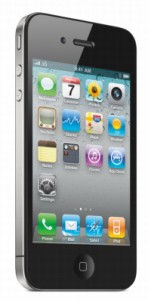Steve Jobs gave a quick demo on Monday of iPhone 4 to show off its new gyroscopic capabilities. These new functions will keep iPhone 4 competitive with new handheld gaming systems, along with – presumably – other iOS-enabled devices that Apple produces in the future.
 From its inception, the iPhone and all related devices that have followed sport an accelerometer – a device that measures acceleration, enabling the iPhone, iPod touch or iPad to know which direction it’s being held in. It’s the accelerometer that enables the iPhone to automatically adjust from landscape to portrait mode. For gaming applications, the accelerometer has been used to enable players to shake the iPhone or tilt it like a steering wheel to make stuff happen on screen.
From its inception, the iPhone and all related devices that have followed sport an accelerometer – a device that measures acceleration, enabling the iPhone, iPod touch or iPad to know which direction it’s being held in. It’s the accelerometer that enables the iPhone to automatically adjust from landscape to portrait mode. For gaming applications, the accelerometer has been used to enable players to shake the iPhone or tilt it like a steering wheel to make stuff happen on screen.
iPhone 4 adds a gyroscope – a device that measures orientation, rather than just velocity. Gyroscopes are commonly used in aircraft to measure pitch, roll and yaw, and the iPhone’s gyro is no different in this regard.
All this may sound pretty esoteric; it’s the realm of aeronautics and spaceflight, after all. I don’t think that we’re going to be seeing astronauts and pilots depending on their iPhones to pilot their vehicles any time soon, for example. But a gyroscope has some great application for games.
When the output of the iPhone’s gyroscope is paired with the output from the accelerometer, iPhone developers will now be able to create applications that can sense motion on six axes – up/down, left/right, forward/backward, combined with rotation around three perpendicular axes – pitch, yaw, and roll.
This will put iPhone 4 well ahead of the capabilities of other smartphones when it comes to playing games, as well as the Nintendo DS and the Sony PSP (Nintendo’s forthcoming 3D handheld system purportedly has similar features, though Nintendo has not, as of yet, formally introduced the device).
This puts the iPhone more into the realm of Nintendo’s Wii home console, which sports similar capabilities when its remotes are paired with a Nintendo-made accessory called the MotionPlus. Sony’s PlayStation 3 controllers also sport gyroscopic functionality.
Apple is exposing iPhone 4’s new functionality with new Application Programming Interfaces (APIs) it’s calling CoreMotion; iOS developers will need to tap into these calls to support gyroscopic functionality in their games.
Jobs briefly showed a tech demonstration of one possible game – a brick-stacking game akin to the tabletop game “Jenga,” in which he tilted and rotated a virtual tower of wooden-looking blocks before knocking them over. It was a simple but effective show of what CoreMotion can do on the iPhone 4 – and already game developers are buzzing about what else they can use the technology for.
One postscript worth mentioning – Apple’s timing for WWDC couldn’t be better. It comes just two weeks before the video game industry’s biggest event of the year, the Electronic Entertainment Expo (E3) in Los Angeles, Calif. Microsoft and Sony are both expected to show how the 3D gaming technology that they’re working on is progressing. Microsoft and Sony both debuted hardware at last year’s event – Microsoft’s “Project Natal,” and Sony’s new Wii-like wand controller.
But while Microsoft and Sony debuted the tech last year and have yet to ship it, Apple has gathered developers in San Francisco this week to learn more about CoreMotion, and are shipping a product that can actually put it to use before the end of the month.
